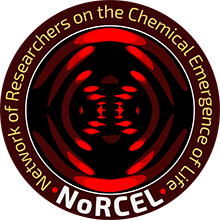It is well known that hydrogen cyanide and formamide can universally be considered as key molecules in prebiotic synthesis. Despite the fact that formamide has been detected in interplanetary and interstellar environments, other prebiotic species are far more abundant, including, for example, formaldehyde. We report on a wide exploration of the formaldehyde and hydrogen cyanide reaction network under plasma conditions mimicking an asteroid descent in an Earth-like atmosphere and its impact. Dielectric breakdown using a high-power kJ-class laser system (PALS – Prague Asterix Laser System) along with quantum mechanical, ab initio molecular dynamics, and enhanced sampling simulations have been employed in order to mimic an asteroid impact plasma.
We show that plasma reprocessing of formaldehyde or hydrogen cyanide leads to the formation of several radical and molecular species along with formamide. All the canonical nucleobases, the simplest amino acid (i.e., glycine), and the sugar ribose, have been detected after treatment of formaldehyde and nitrogen gas with dielectric breakdown.
Our results, supported by quantum mechanical and enhanced sampling simulations, show that formaldehyde – by producing inter alia formamide – may have had the role of starting substance in prebiotic synthesis. In contrast, hydrogen cyanide chemistry does not involve synthesis of formamide and represents an independent high energy way for one pot synthesis of all the canonical nucleobases.


